Swimming and gnawing beavers
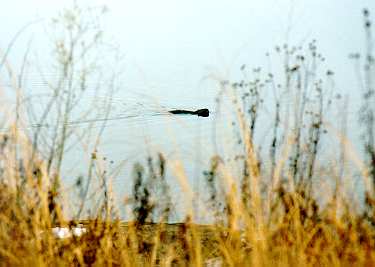
|
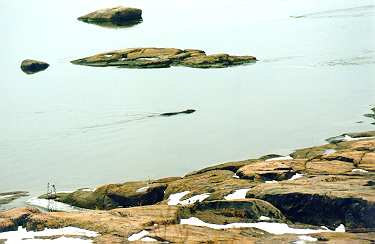
|
|---|

|

|
|---|
The best time for beaver watching is the period just before the beginning of winter. When beavers feel that everything will freeze over any time, they try to gather as much last minute winter supplies as possible, and may cease to be timid for a while. If you do not bother them, they will often allow you to watch them from immediate proximity. Once, when skating on the Fish Creek at the southern edge of Calgary, Alberta, I was able to watch a beaver from only about two meters away. It was when only a narrow hole through the ice near the bank was remaining through which that beaver could get into the water, and then into his underground lodge. This hole was getting narrower and narrower as the ice coverage of the creek was growing from above due to water gushing continually onto the ice surface along the banks in some places of the creek. This beaver was gnawing off small trees or rather bushes (2 m high at most) on the other side of the stream, and when finished, pulled them immediately across the ice into his hole. Each time he was setting into the motion with a new tree, his legs were slipping on the ice, and he moved them faster and faster. Almost like the wheels of a car spinning on an icy road under a heavy foot on the accelerator. The next problem for the beaver was to pull the whole tree through that narrow hole in the ice. The beaver went in first, then I could see the tree slowly disappearing after him, with its top often jerking in various directions as the beaver tried to get it over the obstacles in the passage. Only if the tree got hopelessly stuck, did the beaver get out to cut off the branches or cut the trunk into smaller pieces. So he was busying himself apparently the whole day. The next day, the beaver's hole was completely covered by ice.
Unlike that, the Pinawa bridge beavers were very timid and cautious all the time this fall. Perhaps because of the unusually long and warm fall were they able to cut trees at leisure for a longer time than usual, and there was no need for any last minute rush before the freeze up. In the beginning, they were often submerging after noticing my presence even before I noticed them. I just heard the typical strong bang that sounds almost like a gun shot. When beavers want to submerge fast, they do it with a powerful strike of their wide flat tail, which propels them under the water almost instantaneously by a few meters. The purpose of such loud bangs could also be to frighten a potential attacker. If they want, they are also able to submerge without giving out a noise. The form of their escape apparently depends on their perception of danger.
When swimming underwater, beavers have to breathe in from time to time. They do it so masterfully that they hardly disturb the surface of the water. When there are even tiny waves, it is impossible to tell that a beaver is swimming underneath. Only once, when the water level was perfectly still like a mirror, did I notice after a beaver submerged that every 5 or 10 meters two tiny dots appeared in places where the beaver touched with his nose the water surface from below, and was drawing in the air through his nasal holes. This act disturbed the water surface so little that the disturbance spread out only a few centimeters, and water surface straightened out very fast again. It was necessary to be very attentive not to miss the place of the next breathe-in as the beaver did not move in a straight line all the time.
Later on, the beavers got used to my wandering around their kingdom to such an extent that they stayed on the surface unless I approached them closer than some 20 to 30 m. And so on November 16, I was able to take the above pictures of one of them swimming near the bank close to point 3 (on the map).
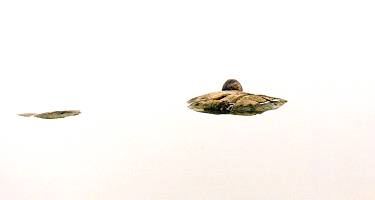
|
Nevertheless, they were still afraid to venture on the shore in my presence - I think that two beavers were around at that time. After a while one of them decided not to waste any more of his time by swimming around me in circles, climbed onto a rocky outcrop sticking out from water, and cowered behind that outcrop at least started chewing on some twigs he found there. The outcrop was about 15 m from the bank, and I was still another 10m further. |
|---|
| When I tried to approach somewhat closer, the beaver did not like it, abandoned the twigs, and, this time noiselessly, submerged and disappeared. I only managed to take his picture a fraction of a second before he slipped into the water. |
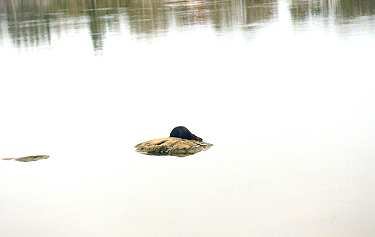
|
|---|
| Below I have electronically enlarged the beaver from the previous two pictures. On the left you can now see well also the twig he was chewing on. On the right the graceful curve of his body ready to penetrate the water surface with as little resistance as possible. | |
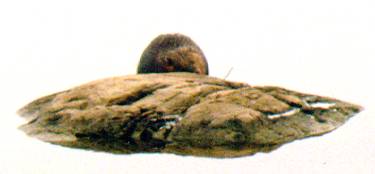
|
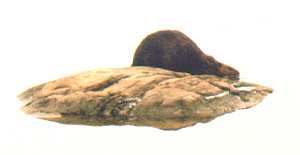
|
|---|---|
I do not know how many beavers live there altogether. An extended beaver family can live in one lodge - the pair who started the lodge with some of their adult children (while other young do leave every year to start new lodges), and perhaps some aunts and uncles. At most I found four adult beavers at one time and place - at about 11 pm. I assume that after my arrival they must have moved into the river from cutting the trees ashore. Three of them at least stayed at the edge of water where they continued gnawing at some branches just a few meters under my feet, but the fourth one preferred to circle in the water around. The moon was shinning but in spite of that I could only see their dark shadows, and I am not equipped for night photography. When gnawing at branches and tree trunks, the beavers do so with large vivacity and speed, producing a typical sound of almost constant frequency that may remind a machine, and especially at night can be heard from at least dozens of meters away.
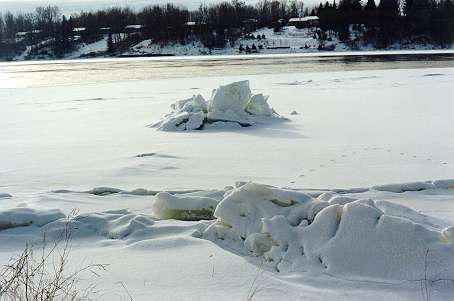
| The rock outcrop on which the beaver sat above, capped with big chunks of ice on January 25. |
|---|
|
The same place from the bridge. It is a lonely rock some distance apart from the
group of rocks shown on the third page, and visible on the
second picture above, which are in this picture just behind the car tracks (at point 3, circling the fire pit) on the left.
January 26. |
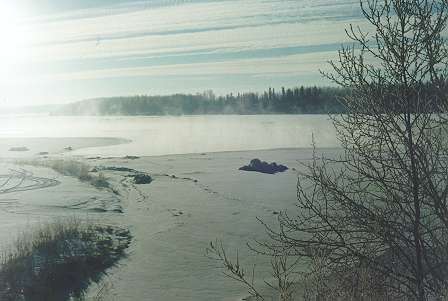
|
|---|